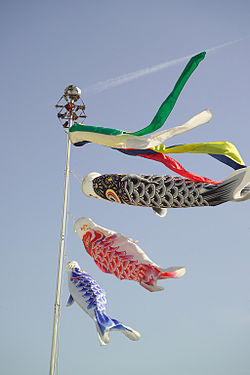
Back يوم الأطفال Arabic Uşaqlar Günü (Yaponiya) Azerbaijani Kodomo no hi Czech Kodomo no Hi German Κοντόμο νο χι Greek Infana Tago (Japanio) Esperanto Kodomo no Hi Spanish روز کودکان (ژاپن) Persian Lasten päivä Finnish Kodomo no hi French
| Children's Day | |
|---|---|
 | |
| Official name | 子供の日 (Kodomo no hi) |
| Observed by | Japan |
| Type | Public |
| Significance | Celebrates children's personalities and their happiness |
| Celebrations | A public holiday in Japan |
| Observances | It was designated a national holiday by the Japanese government in 1948, but has been a day of celebration in Japan since ancient times |
| Date | May 5 |
| Next time | 5 May 2025 |
| Frequency | Annual |
| Related to | Golden Week (Japan), Tango no Sekku, Duanwu Festival, Dano Festival, Tết Đoan Ngọ |
Children's Day (こどもの日, Kodomo no hi) is a public holiday in Japan which takes place annually on May 5 and is the final celebration in Golden Week. It is a day set aside to respect children's personalities and to celebrate their happiness. It was designated a national holiday by the Japanese government in 1948, but has been a day of celebration in Japan since ancient times.[2][3]
Children's Day has officially been a day to wish for the happiness of both male and female children since 1948,[2][3] but its origin, Tango no Sekku, was a day for boys from the Kamakura period in the 12th century to the mid-20th century, and the customs of Children's Day still retain vestiges from that time.[4]
- ^ Perkins, Dorothy (1991). Encyclopedia of Japan: Japanese History and Culture, from Abacus to Zori. Facts on File. p. 46. ISBN 9780816019342. Retrieved May 3, 2018.
- ^ a b Cite error: The named reference
kidswas invoked but never defined (see the help page). - ^ a b Cite error: The named reference
Japan Societywas invoked but never defined (see the help page). - ^ Cite error: The named reference
yuraiwas invoked but never defined (see the help page).
© MMXXIII Rich X Search. We shall prevail. All rights reserved. Rich X Search